By: Robert Avsec, Executive Fire Officer
In 2001 I wrote on the following topic for my fourth and final Applied Research Project (ARP) , Succession Planning 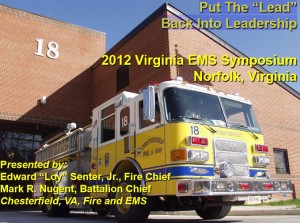 in Chesterfield Fire and Emergency Medical Services, to complete my graduation requirements for the National Fire Academy’s Executive Fire Officer Program (EFOP). The following is an excerpt from the ARP’s Abstract:
in Chesterfield Fire and Emergency Medical Services, to complete my graduation requirements for the National Fire Academy’s Executive Fire Officer Program (EFOP). The following is an excerpt from the ARP’s Abstract:
Chesterfield Fire and Emergency Medical Services, located in Chesterfield County, Virginia, faces a tremendous challenge to its ability to provide competent leadership for the organization. Over the next five to seven years the department can expect to lose approximately ninety career members to length-of-service retirements, the first large scale turnover for an organization that has only had a few such retirements to date. Many of these retirees will be officers throughout the ranks, many who have been with the department since its formative years. In addition, the department has five additional fire stations that are to be built over that same period bringing ninety new employees into the organization.
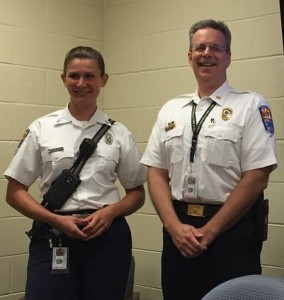
Battalion Chief Joy Wallace and Fire Chief Ed Senter
CFEMS made history this past Friday in recognizing the promotion of the largest number of officers at one time in its history: 13 lieutenants, 10 captains, 3 battalion chiefs, and 1 assistant chief. Within that group, the department promoted its first woman to the rank of battalion chief, Joy Wallace.
See Related: Put the “Lead” Back into Leadership
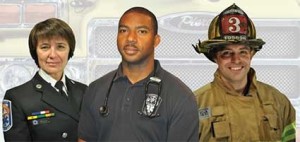 By most measures, CFEMS is a relatively “young” department having hired its first career Fire Marshal, Robert L. Eanes, in 1967 to develop the county’s fire codes. Eanes would later become the department’s first career Fire Chief, in 1968 to lead the county’s separate and autonomous volunteer fire departments of the time. The first group of twelve career firefighters were hired in October of 1969.
By most measures, CFEMS is a relatively “young” department having hired its first career Fire Marshal, Robert L. Eanes, in 1967 to develop the county’s fire codes. Eanes would later become the department’s first career Fire Chief, in 1968 to lead the county’s separate and autonomous volunteer fire departments of the time. The first group of twelve career firefighters were hired in October of 1969.
See Related: What the Executive Fire Officer Program meant to me and my department
Chief Eanes laid the foundation for the department’s “homegrown” leadership when he assembled a group of fire officers from across the ranks of the department in 1985 to begin developing an Officer Development Program (ODP). The ODP—whose target audience was firefighter who aspired to promotion to the rank of Company Officer and incumbent Company Officers—was launched only a few short years later and would continue to be nurtured through the leadership of Eanes’ successors as Fire Chief.
(In CFEMS, the basic company officer is a lieutenant; a captain can be a company officer–along with having management responsibilities for their fire station–or fill a staff officer role).
Those successors, Wesley Dolezal, Steve Elswick, Paul Mauger, and the incumbent Fire Chief, Ed Senter have
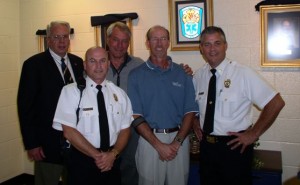
The author (short and front) with former CFEMS Fire Chiefs (L-R) Robert Eanes, Wesley Dolezel, Steve Elswick, and Paul Mauger (Himself now retired).
continued to grow the original ODP and its successors:
- ODP I for the original target audience;
- ODP II for lieutenants seeking to become Captains; and
- Applied Leadership for Company Officers, an eight-week program that meets once a week to prepare those firefighters on the current Lieutenant’s Promotion Eligibility List with practical information and skills training to prepare them for the “huge” step from firefighter to first-line supervisor.
In addition to the formal ODP programs that were developed, there’s also a “shadow” officer development program: the CFEMS ALS Training Program and ALS Continuing Education Program. I remember, as a staff officer, “running some numbers” one time for Chief Mauger and at that time something like 90% of the incumbent lieutenants and captains possessed ALS certification.
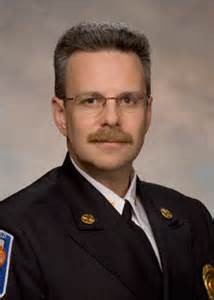
Current CFEMS Fire Chief Edward “Loy” Senter
I attributed that high number–and it may have been greater than 90%–to the impact that gaining one’s ALS certification requires one to develop: (1) critical thinking skills; (2) the ability to prioritize and handle multiple problems; and (3) manage people and resources to accomplish a task. And aren’t those the same attributes of a good officer?
Many people contributed to these outstanding programs and proof is in who’s coming out of the “pipeline” to lead, guide and direct the good men and women of CFEMS at all levels. So once again, congratulations to everyone, past and present”, who’s keeping the leadership of CFEMS “homegrown”!
 Fire & EMS Leader Pro The job of old firefighters is to teach young firefighters how to become old firefighters!
Fire & EMS Leader Pro The job of old firefighters is to teach young firefighters how to become old firefighters!